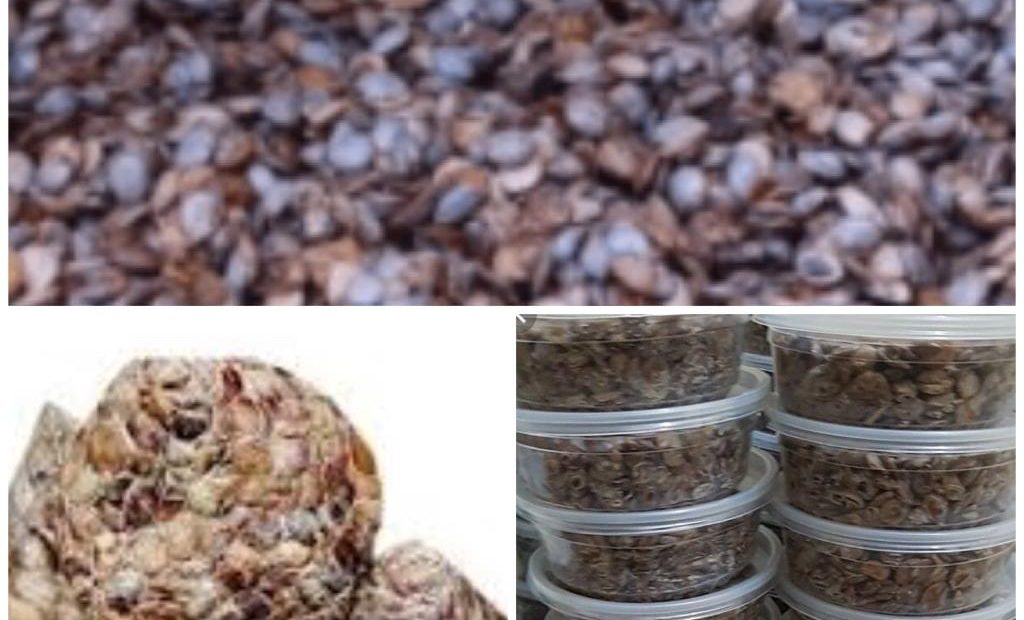

By Titilayo Kupoliyi
Locust beans, an aromatic local seasoning widely used in preparing soups and stews across West Africa is scientifically known as Parkia biglobosa.
It is called ‘iru‘ by Yoruba, ‘ogiri‘ by Igbo, and ‘dawa dawa’ by Hausa. It is also known as Irú or Eware among the Edo people of Nigeria.
Locust beans is cultivated from a perennial deciduous tree found in Africa.
It is worthy to note that locust beans isn’t just a culinary condiment, as it has valuable nutritional properties and myriads health benefits, besides other numerous uses.
Iru is mainly used as a condiment for cooking.
Yorubas classify Iru into two types: Iru Woro, which is commonly used to make stew, and Iru Pete, which is used to make ewedu and egusi soup.
The leaves of the locust beans tree are also used to wrap moi moi.
Also, the seeds are also used as animal feed for livestock and poultry.
The plant is also used is some parts of Africa to treat wounds, hypertension, malaria and bacterial infections, because it is said to contain medicinal properties.
Locust beans is high in lipids, proteins, carbohydrates, fats and calcium.
It also contains a good amount of essential nutrients such as potassium, ascorbic acid, phosphorus, tannin, phytate, oxalate, among others.
A study in 2007 on the Nutritional Composition of the African locust beans attests to the facts above.
It also showed that locust beans contains a fair amount of saponins, phenols and ascorbic acids.
The nutritional value of locust beans indicates that it is an excellent source of macro and micro-nutrients.
Below are some surprising health benefits of locust bean:
Prevents/Treats Diabetes
Locust beans is capable of reducing risk of diabetes. Recent shows that there is a significant relationship between the aqueous and methanolic extracts of locust beans and cholesterol levels. That is, the natural condiment is effective in increasing the levels of ‘good’ HDL cholesterol while lowering that of ‘bad’ LDL cholesterol in the body.
In a similar study published in the journal, Clinical and Experimental Pharmacology, and Physiology, reveals that the blood sugar-lowering the effect of locust beans could be likened to the one exhibited by glibenclamide, a reference anti-diabetic drug.
Additionally, some set of researchers at the Department of Chemical Pathology, College of Health Sciences Ladoke Akintola University of Technology, Osogbo, discovered that locust beans is not only good for protecting against some diabetes complications but also helps in accelerating weight loss and reducing the risk of ischaemic heart diseases.
Regular locust beans intake is considered one of the natural ways of regulating cholesterol levels. This is because the natural condiment contains certain antioxidant and hypolipidaemic properties that interfere with the cholesterol in the body to strike the right balance.
In support of the above, a study published in The American Journal of Clinical Nutrition a few years ago states that locust bean gum could help lower cholesterol as its hypolipidemic effect is being tested in familial. hypercholesterolemic adults and children.
Promotes Healthy Sight
Locust bean is an excellent source of Vitamin A, which promotes good eyesight alongside bone growth and immune system.
Vitamin A in locust beans is one of the essential vitamins the eyes need to function properly.
Chances of developing eye conditions such as night vision, cataracts, and xerophthalmia can be reduced simply by increasing your locust beans intake.
Vitamin A in locust beans also helps in reducing the risk/effects of eyes infections, minus eyes, myopia, glaucoma, etc.
Some medicines use the roots of the locust beans as part of the major ingredients, indicating how effective this natural condiment is.
Treats Hypertension
Hypertension, otherwise known as high blood pressure, occurs when the pressure of blood pumped through the arteries is relatively higher than expected. One thing about this health condition is that it is a silent killer, meaning one may never be aware that one has it even for several years unless one goes for checkups.
Consumption of locust beans has been said to prevent and treat hypertension. This is because the seeds of the condiment are found to be rich in antihypertensive properties. The leaves of locust beans also contain procyanidin, another component proven to be effective in lowering blood pressure in humans.
Remedy for Diarrhea
Diarrhea occurs when there is a sudden increase in the frequency, looseness, and volume of your faeces.
Locust bean contains tannins and pectin, both of which are recommended most times for people with diarrhoea.
In addition to the above, Nyandanu et al., 2017 in a study reveal that leaves, bark, roots, and fruit of African locust bean could be prepared as a local remedy for treating myriads of health conditions, such as fever, diarrhoea, stomach problems, boils, and burns.
In support of this claim, Sina and Traoré, 2002 in a study also reveal that the bark of locust bean can be used locally for treating a wide range of diseases, including diarrhoea, sterility, bronchitis, pneumonia, leprosy, skin irritations, inflammation, parasitic worms, to mention but a few.
Excellent for Gum Health
The mouth is packed with legions of bacteria. Although some are harmless, yet there are some that can attack the teeth and gums to cause certain infections.
However, one of the best ways to prevent /treat gum-related diseases is by consuming locust beans.
These natural condiments contain some properties that are very helpful in healing mouth ulcers and relieving receding gums while also inhibiting the growth of bacteria, causing tooth decay in the mouth.
There are also African countries (such as Cote d’Ivoire) where the bark of locust beans is being infused, soaked and boiled to prepare local mouthwash for steaming and relieving toothache.
Additional Information from Healthguide NG
Subscribe to our Telegram and YouTube Channels also join our Whatsapp